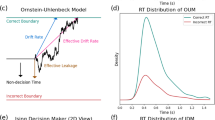Summary
The information-processing (IP) approach to perception and cognition arose as a reaction to behaviourism. This reaction mainly concerned the nature of explanation in scientific psychology. The “standard” account of behaviour, phrased in strictly external terms, was replaced by a “realist” account, phrased in terms of internal entities and processes. An analysis of the theoretical language used in IP psychology shows an undisciplined state of affairs. A great number of languages is simultaneously in use; no level of analysis is unambiguously referred to; and basic concepts such as information and processing remain largely undefined. Nevertheless, over the past 25 years the IP approach has developed into a disciplined and sophisticated experimental science. A look at actual practice hints at the basic reason for its success. The approach is not so much concerned with absolute or intrinsic properties of the human information processor, but with what can be called its relative or differential properties. A further analysis of this feature of the IP approach in terms of the formal language of a logical system makes explicit the basis of its success. The IP approach can be regarded as developing an empirical difference calculus on an unspecified class of objects, phrased in terms of a simulated “theory-neutral” observation language, and with operators that are structurally analogous to logical operators. This reinterpretation of what the IP approach is about brings a number of advantages. It strengthens its position as an independent science, clarifies its relation with other approaches within psychology and other sciences within the cognitive science group, and makes it independent of philosophical subtleties.
Similar content being viewed by others
References
Allport, D. A. (1980). Patterns and actions: Cognitive mechanisms are content-specific. In G. Claxton (Ed.),Cognitive psychology: New directions. London: Routledge and Kegan Paul.
Allport, D. A. (1987). Selection for action: Some behavioral and neurophysiological considerations of attention and action. In H. Heuer & A. F. Sanders (Eds.),Perspectives on perception and action. Hillsdale, N. J.: Erlbaum.
Amundsen, R. (1985). Psychology and epistemology: The place versus response controversy.Cognition, 20, 127–153.
Anderson, J. R. (1980).Cognitive psychology and its implications. San Francisco: Freeman.
Bartlett, F. C. (1932).Remembering. Cambridge: Cambridge University Press.
Bieri, P. (1990). Informational accounts of perception and action. In O. Neumann & W. Prinz (Eds.),Relationships between perception and action. Berlin, Heidelberg, New York: Springer.
Carnap, R. (1947).Meaning and necessity. Chicago: University of Chicago Press.
Feyerabend, P. K. (1965). The problems of empiricism. In R. G. Coloday (Ed.),Beyond the edge of certainty. Englewood Cliffs, NJ: Prentice Hall.
Flanagan, A. J. (1984). The sience of mind. Cambridge, MA: MIT Press.
Fodor, J. A., & Pylyshyn, Z. W. (1981). How direct is visual perception? Some reflections on Gibson's “Ecological Approach.”Cognition, 9, 139–196.
Fodor, J. A., & Pylyshyn, Z. W. (1988). Connectionism and cognitive architecture: A critical analysis.Cognition, 28, 3–71.
Gibson, J. J. (1941). A critical review of the concept of set in contemporary experimental psychology.Psychological Bulletin, 38, 781–817.
Gibson, J. J. (1979).The ecological approach to visual perception. Boston: Houghton Mifflin.
Hebb, D. O. (1949).The organization of behavior. New York: Wiley.
Hebb, D. O. (1980). A behavioral approach. In M. Bunge (Ed.),The mind-body problem: A psychological approach, Oxford: Pergamon.
Van der Heijden, A. H. C. (1984). Cognitive psychology and the mindbody problem. Internal Report, University of Leiden.
Kandel, E. R., & Schwarz, J. H. (1985).Principles of neural science (2nd ed.). New York: Elsevier.
Kuhn, T. S. (1962).The structure of scientific revolutions. Chicago: University of Chicago Press.
Lovie, A. D. (1983). Attention and behaviourism — fact and fiction.British Journal of Psychology, 74, 301–310.
McClelland, J. L., & Rumelhart, D. E. (1986).Parallel distributed processing (Vol 2).Psychological and biological models. Cambridge, MA: MIT Press.
Manicas, P. T., & Secord, P. F. (1983). Implications for psychology of the new philosophy of science.American Psychologist, 38, 399–413.
Marr, D. (1982).Vision. San Francisco, CA: W. H. Freeman.
Massaro, D. W. (1986). The computer as a metaphor for psychological inquiry: Considerations and recommendations.Behavior Research Methods, Instruments and Computers, 18, 73–92.
Massaro, D. W. (1987). Information processing theory and strong inference: A paradigm for psychological inquiry. In H. Heuer & A. F. Sanders (Eds.),Perspectives on perception and action. Hillsdale NJ: Erlbaum.
Neisser, U. (1967).Cognitive Psychology. New York: Appleton-Century-Crofts.
Neisser, U. (1976).Cognition and reality. San Francisco: Freeman.
Palmer, S. E., & Kimchi, R. (1986). The information processing approach to cognition. In R. J. Knapp & L. C. Robertson (Eds.),Approaches to cognition: Contrasts and controversies. Hillsdale, NJ: Erlbaum.
Paschal, F. C. (1941). The trend in theories of attention.Psychological Review, 48, 383–403.
Quine, W. V. (1960).Word and object. Cambridge, MA: MIT Press.
Ramsey, F. P. (1931).The foundations of mathematics. London: Routledge & Kegan Paul.
Rumelhart, D. E., & McClelland, J. L. (1986).Parallel distributed processing (Vol. 1)Foundations. Cambridge, MA: MIT Press.
Russell, B., & Whitehead, A. (1970)Principia mathematica. Cambridge: Cambridge University Press.
Scheerer, E. (1988). Towards a history of cognitive science.International Social Science Review, 115, 7–19.
Tolman, E. C. (1932).Purposive behavior in animals and men. New York: Appleton-Century-Crofts.
Tolman, E. C. (1948). Cognitive maps in rats and men. Repr. in E. C. Tolman (1951),Behavior and psychological man. Berkeley: University of California Press.
Treisman, A. (1988). Features and objects: The fourteenth Bartlett memorial lecture.Quaterly Journal of Experimental Psychology, 40A, 201–237.
Author information
Authors and Affiliations
Rights and permissions
About this article
Cite this article
van der Heijden, A.H.C., Stebbins, S. The information-processing approach. Psychol. Res 52, 197–206 (1990). https://doi.org/10.1007/BF00877528
Issue Date:
DOI: https://doi.org/10.1007/BF00877528



